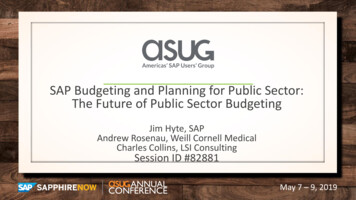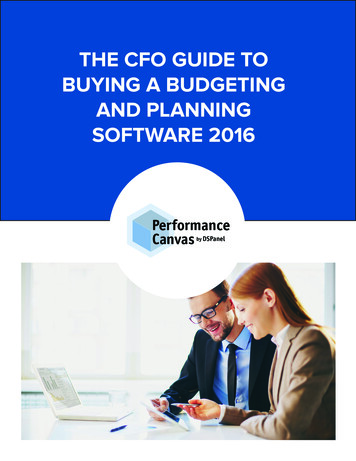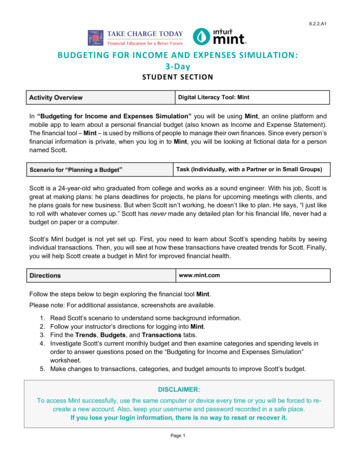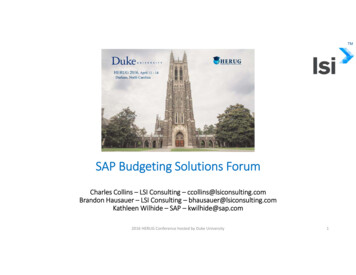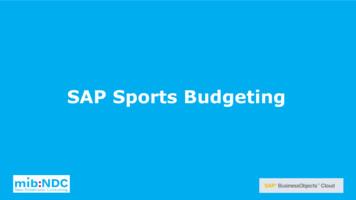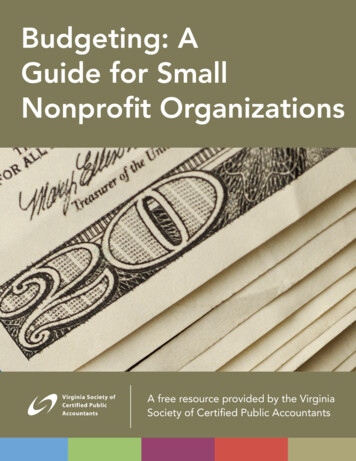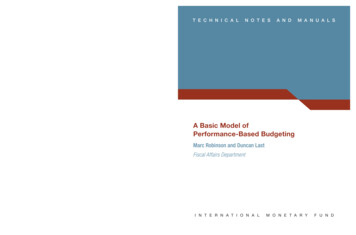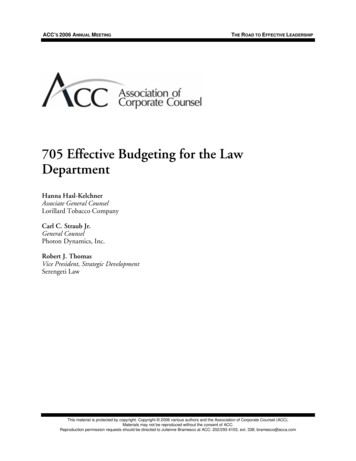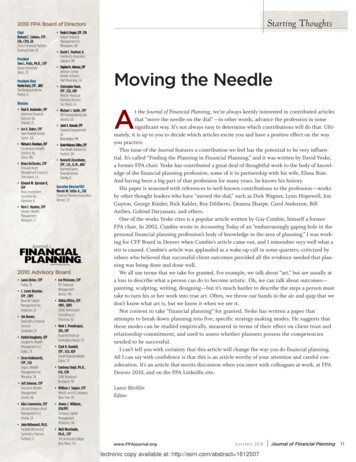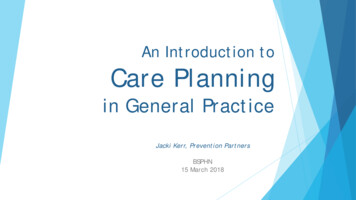
Transcription
INTRODUCTION TO PLANNING,BUDGETING AND FORECASTINGMODELS - SEMINARROME – LA SAPIENZA2017, MAY 4TH
AGENDAENTERPRISE PERFORMANCE MANAGEMENT – AN OVERVIEWPLANNING, BUDGETING AND FORECASTING MODELCopyright 2017 Accenture All rights reserved.2
ENTERPRISE PERFORMANCE MANAGEMENT - OVERVIEWEnterprise Performance Management (EPM) is a strategy and key capabilities required to makedecisions and take actions to drive shareholder ionBusinessStrategyTotalReturns toShareholdersOperateAn effective EPM capability enables to focus and align the organization to the key drivers of itsstrategy, to plan and forecast based on these drivers, to measure results, and course correctlyaccordingly.Copyright 2017 Accenture All rights reserved.3
ENTERPRISE PERFORMANCE MANAGEMENT CAN HELP ACOMPANY CREATE VALUE ALONG A NUMBER OF DIMENSIONSEFFECTIVENESSEFFICIENCY Focuses and aligns management around thekey drivers of value Provides fact-based guidance for valuebased decision making Enables a consistent process and frameworkfor the evaluation of decision trade-offs(current/future) around investments Supports driver-based planning andforecasting to enable predictive anddynamic resource allocation Balances focus on strategy/operationsaround key value drivers Aligns incentives and rewards closer toshareholder value creation Streamlines planning and reportingprocesses using consistent key drivers ofvalue Streamlines decision making Improves focus of resource time and effort,eliminates redundant work and minimizesmanual intervention and errors Integrates processes and controls toimprove integrity of data and quality ofoutputs Provides a strong value-based foundationfor Infrastructure improvements Dynamic learning capability leveragesresource time more efficientlyCopyright 2017 Accenture All rights reserved.4
KEY FINDINGS RELATED TO ENTERPRISE PERFORMANCEMANAGEMENTIn today's highly volatile global economy the traditional approach to planning has been renderedobsolete - it is not effective, nor fast enough.SituationEvidenceCompanies have made and are continuing to makesignificant investments in planning capabilities77% of companies change their planning processevery year; 85% are planning to enhance their coreplanning capabilities in the next 1-2 yearsIn practice, the value created has been limitedOnly 11% of companies today are fully satisfied withtheir planning capabilities, compared to 17% two yearsago and 20% a decade agoBusiness plans and budgets quickly become obsoletedue to volatility in the markets, commodity prices andexchange ratesAlmost two thirds of companies quote budgets as amajor constraint in their ability to respond to changesin the business environmentManaging in uncertain times requires higher flexibilityon how and when actions need to be taken(investment and Opex decisions)In a recent Conference Board report, “speed, flexibilityand adaptability to change” ranked as #3 among topCEO challengesDeviations of corporate performance from marketguidance confirm that forecasts have been createdunder very different business conditionsMore than two thirds of companies admit that theirplanning accuracy has diminished due to businessvolatility, while more than 80% recognize that itsimportance has increased for the same reasonCopyright 2017 Accenture All rights reserved.5
THE EPM FRAMEWORKPERFORMANCE MANAGEMENT FRAMEWORKTarget SettingStrategic Plan & ObjectivesDetermine KeyMeasures ofSuccessDetermine KeyValue DriversForecasting & MonitoringRefine CorporateVision & StrategyObjectivesDevelop Action Plans,Re-allocate Resourcesand Update ForecastPortfolio ValueAssessmentEnablersSet Targets forKey Measures ofAccountabilityCascade Targets toLower Level Metrics/OrganizationIncentives& RewardsStandardizedprocessesIntegrated ITArchitectureData structures &controlsLeadership &governanceCopyright 2017 Accenture All rights reserved.AllocateResources(capital & people)to Achieve PlansMonitor Key Measuresof BusinessPerformanceClose and ConsolidateBooks and ReportActualsPlanning & BudgetingDevelop Plans toAchieve TargetsReview Performancewith ExecutiveManagementReview,Challenge &Finalize Plans &BudgetsSource: Accenture6
THE EPM FRAMEWORKPERFORMANCE MANAGEMENT FRAMEWORKTarget SettingStrategic Plan & ObjectivesDetermine KeyMeasures ofSuccessDetermine KeyValue DriversForecasting & MonitoringRefine CorporateVision & StrategyObjectivesDevelop Action Plans,Re-allocate Resourcesand Update ForecastPortfolio ValueAssessmentEnablersSet Targets forKey Measures ofAccountabilityCascade Targets toLower Level Metrics/OrganizationIncentives& RewardsStandardizedprocessesIntegrated ITArchitectureData structures &controlsLeadership &governanceCopyright 2017 Accenture All rights reserved.AllocateResources(capital & people)to Achieve PlansMonitor Key Measuresof BusinessPerformanceClose and ConsolidateBooks and ReportActualsPlanning & BudgetingDevelop Plans toAchieve TargetsReview Performancewith ExecutiveManagementReview,Challenge &Finalize Plans &BudgetsSource: Accenture7
AGENDAENTERPRISE PERFORMANCE MANAGEMENT – AN OVERVIEWPLANNING, BUDGETING AND FORECASTING MODELCopyright 2017 Accenture All rights reserved.8
PLANNING, BUDGETING AND FORECASTING KEY PROCESSES Strategic Planning is the development of a long-term planaimed at establishing the organisation’s strategicpositioning and driving value creation over and abovecompetitors Target Setting & Operational Planning is the process oftranslating the organisation’s strategic plan intoquantifiable and measurable key performance indicatorsfor each business unit, and establishing specific actionplans to achieve the stated goals. Budget Creation & Approval is the process where targetsare translated and expressed into quantitative terms,describing the expected financial performance of theorganisation over the next year. Forecasting is the act of predicting outcomes and is doneperiodically throughout the year to reflect changes thathave occurred both in the internal and externalenvironment since the budget was developed. It’s mainobjective is to provide more accurate and timelyinformation for better and less risky management planningand decision making.Copyright 2017 Accenture All rights ion&ApprovalForecastingEnterprise Performance ManagementSystems EnablementOrganisation Structure and Capabilities Systems Enablement – Theinformation systems used tocapture, retrieve and analyseboth inputs and outputs of theplanning, budgeting andforecasting process. Organisation structure and capabilities isthe structure in which the financeorganisation operates and interacts with thebroader business, and the level of financialacumen present throughout the business.9
PB&F PROCESSES KEY ROLESThe Accountability Structure outlines the main responsibilities for in-life management of resources. Provide strategic/long term guidance Define long range plan (LRP) Set central and local targetsC-Level Approve plans and budgets Prepare plans and budget Review and approve forecasts and monitoringP&CDept. Create annual budget and quarterly forecast Perform variance analysis (consolidated) Approve action plan Support preparation of plans and budget Prepare forecast and monitoringBusiness Unit Perform variance analysis (local level) Prepare and agree action plansCopyright 2017 Accenture All rights reserved.10
PB&F PROCESSES TYPICAL RESPONSIBILITIESOutline guidancefor operationalplansDevelopoperationalplansC-Level /ExecutivesConsolidateplans/ budgetsDevelopbudgetsAgree and signoff onplans/ mentForecastingBudgetingPlanningStrategic Planning AFC (Central / Local) Business Unit Local Operating Units Copyright 2017 Accenture All rights reserved.11
PLANNING BUDGETING AND FORECASTING “V-MODEL”Leading companies employ a top-down and bottom-up approach to identify and closegaps between budget and targetsApprove & finalizeplansPrepareTargetsObtainAgreementon TargetsEstablish Corporate /Europetargets andcascade to BU’sRefine plansto close gapsReview againsttargetsManagement Reviewsand Approves PlanFinalize Corporate /Europe ConsolidatedPlanChallenge Business UnitplansCorporate/CentralBusiness UnitDevelop BU strategy andtranslate into tacticsCopyright 2017 Accenture All rights reserved.Determine WorkActivities and ProjectsRequired to AchieveResultsCreate BU planning andbudget (Expenses, Sales,Margin, etc.)12
PB&F – RACI MATRIX EXAMPLERACI EXAMPLE for In-Life ManagementC - Level /ExecutivesCentral AFCLocal AFCBusiness UnitLocal OperatingUnit1. LRP (annual)AR/CCII2. Target Setting (annually)ARCIIA/CC/RRCC4. Forecasting (quarterly)IA/RCRC5. Monitoring (monthly)IA/RCRCR: Responsible – “Does the work”A: Accountable – “Approves”C: Consulted – “Provides inputs”I: Informed – “Receives communication”Has direct responsibility for the process and leads or does the work to shape that resultHas final responsibility for the process result and has the authority to decide on courses of actionConsults and helps shape the outcome of the processIs informed about the process and outcomesProcess3. Planning & Budgeting (annually)Copyright 2017 Accenture All rights reserved.13
PLANNING, BUDGETING & FORECASTING – PROCESS TIMINGLeading organizations complete Target Setting and Budgeting in 3 months, spending most of thetime on analysis (not production)FY16AugSeptOctStrategicPlanning (LRP) Understandinternal andexternalenvironment Identify 3 yearsenterprise-wideKPIs and targets Set / revise 3 yearStrategic Plan Identify keyprojects /initiativesNovDecJanTarget Setting and Budgeting ProcessBudgetFinalTarget Setting Set KPIs andtargets for BUs Determineservice levelagreements forBUs Develop actionplans with cleartimelines forBUsBudget Development and Approval Develop “model” budgets Perform “bottom-up” budgeting based onestablished strategic plan and targets (incl.budget deep-dives for selected BUs) Approve budgets at Central and BU levelsForecasting FY16Forecasting FY17 (ongoing) Forecast revenue / cost drivers on a monthly basis for the remaining financial year at Central and BU level Compare budgeted and forecasted figures at Central and BU levelMonitoring/Performance Management (ongoing) Utilize the anticipated enterprise management accounting and performance reporting capabilities Track, analyze and report actual performance against budget and forecast at Central and BU levelsCopyright 2017 Accenture All rights reserved.14
PB&F RELATED TYPICAL QUOTESCopyright 2017 Accenture All rights reserved.15
SWOT ANALYSIS - OVERVIEWStrengthsWeaknessesCharacteristics that place the businessor project at a disadvantage relative toothers.Characteristics of the business orproject that give it an advantage overothers.Are specific to the context of analysis and can be changed through policy or intervention proposed. Theyconcern the variables of the production system and on which you can act directly to achieve strategic goals.OpportunitiesElements that the project could exploitto its advantage.SWOTanalysisThreats/ChallengesElements in the environment that couldcause trouble for the business or projectDerived from the external environment so the direct intervention to govern of the phenomenon is impossible buttheir identification may allow the establishment of measures to prevent/minimize the expected adverse effectsand exploit/promote positive ones.Copyright 2017 Accenture All rights reserved.16
SWOT ANALYSIS – REAL CASE EXAMPLE ON PB&F PROJECTStrengthsWeaknesses1. On question level:1. The vast majority of Marketing PB&F activities areperformed manually in local Excel filesa) learnings from the past and historical data havethe highest current state rating2. Lack of standardization in process and systemsb) It appears that Marketing PB&F KPIs are closelylinked to the channel KPIs3. Limited control and visibility from Europe centrallevel2. There is a commonly recognized importance and needfor improvement in the overall Marketing PB&FprocessOpportunities4. Limited support from central team to BUs and lack ofclarity around roles and ownershipSWOTanalysis1. Clear need for improvement towards standardizedprocesses and systems is recognized by both EuropeCentral and local/BU level2. Align Accountability Structure and Business Rhythmsbetween Local BUs and Europe CentralThreats/Challenges1. Although the need for improvement in all categories isone of the key findings, the BUs indicate a muchsmaller gap between current and desired state thanEurope Central, which might cause resistance tochange at local/BU level2. The level of investment and analysis in completionand usage of Marketing PB&F – as largest gapbetween current and desired state – is not sufficientlyclosedCopyright 2017 Accenture All rights reserved.17
PB&F – KEY INITIATIVES TO IMPROVE PB&FPeopleChange Mindsets Driver-based mindset (avoid accounting mindset) Value awareness Budget and forecast accuracy through mutual trustBuildCompetencies Competence model / matrix Decentralized model configuration and know-howClarify Roles &Responsibilities Clarity of roles on functional and tech support Greater ownership from businessFosterCommitment Commitment procedure with linkage to incentives and rewards Clear guidelines communicating overall strategy and priorities Acceptance of organization's vision, policies and impact Scenario definitionTrigger identification and prioritisationCause and effect on current/future valueValue drivers and KPIs identified and prioritisedEffective commitment procedureBottom-up validation of top-down targetsBalance scorecard to clarify commitment and communication (mgmt tool)Distinction from target setting processDriver-based and block budgetingDecentralised budgeting Reflects best guess based on known assumptions (mindset)Originates from people with deepest insightsTrue rolling forecastVariance analysis (Actual vs. Budget)Balanced scorecard to track targetsGap analysis (Forecast vs. Target) drives corrective actionsMulti-dimensional, self-serve, drag-and-drop reportingImprove DataIntegrity Self-service reportingWorkflow managementVersion controlControls and validationSecurityUser-configurable modelsMaster data integration and maintenanceData reconciliation and validationEstablishInfrastructure Scalable Performance optimized for data and user volumesDeploy ScenarioPlanning CapabilityHow toimprovePB&F?Implement TargetSetting ProcessProcessesImprove BudgetProcess EfficiencyRevise ForecastingProcessImproveMonitoring andFollow upReplaceApplicationsTechnologiesCopyright 2017 Accenture All rights reserved.18
PB&F – PROJECT APPROACH TO IMPROVE EFFICIENCY ANDEFFICACY21Assess & Design(conceptually)3Design (detailed) & DevelopDeploy4ManageA typical project approach is made by four main Activities, each ofwhich has a one ore more Deliverable.Copyright 2017 Accenture All rights reserved.19
WRAP-UP An effective Enterprise Performance Management capabilityenables to focus and align the organization to the key drivers of itsstrategy, to plan and forecast based on these drivers, to measureresults, and course correctly accordingly Planning, Budgeting and Forecast concerns processes followedby the companies in order to be aligned to the Business LongTerm Strategy and to constantly monitor the organizationpositioning.Copyright 2017 Accenture All rights reserved.20
Enterprise Performance Management Systems Enablement –The information systems used to capture, retrieve and analyse both inputs and outputs of the planning, budgeting and forecasting process. Organisation structure and capabilities is the structure in which
